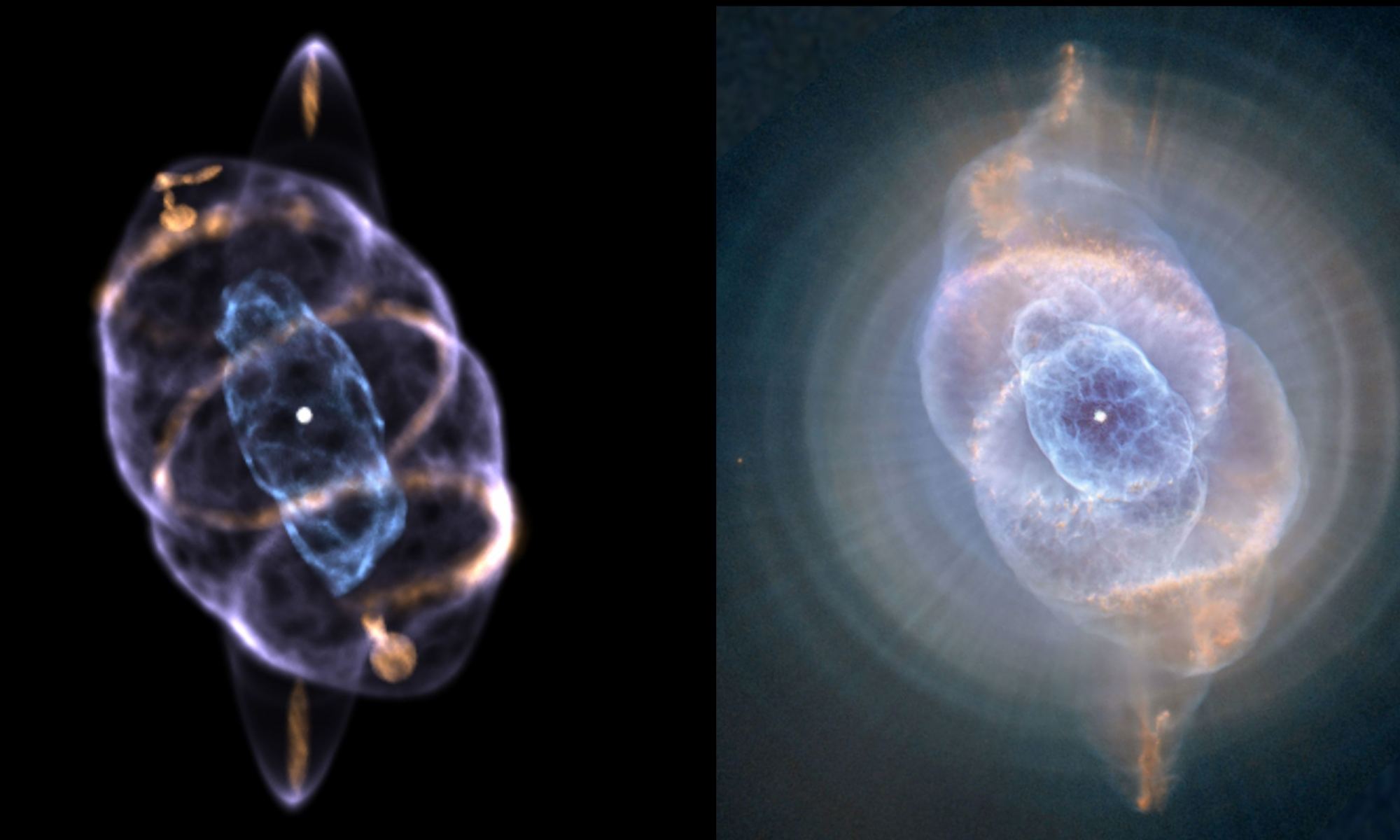In a recent study published in Monthly Notices of the Royal Astronomical Society, an international team of researchers led by Stanford University have produced the first computer-generated 3D model of the Cat’s Eye Nebula, which unveiled a symmetric pair of rings that enclose the outer shell of the nebula. This study holds the potential for helping us better understanding the nebula’s makeup and how it formed, as the symmetric rings provides clues that they were formed from a precessing jet, which produces strong confirmation that a binary star exists at the nebula’s center.
The Cat’s Eye Nebula, also known as NGC 6543, is located approximately 3,000 light-years from Earth, and is one of the most breathtaking images of the night sky. Like most planetary nebulas, it was formed when the outer layer of gas is ejected by a dying solar-mass star. Images from the Hubble Space Telescope (HST) reveal a complex composition of arc-like filaments, knots, and spherical shells, which only adds to its beauty.
The mysterious structure of Cat’s Eye has dumbfounded scientists for years, as they couldn’t figure out how traditional theories of planetary nebula formation could explain its complex shape. Research in recent years demonstrated that precessing jets could act as shaping mechanisms in nebulae such as NGC 6543, but at the same time lacked a detail model to corroborate these claims.
That was until Ryan Clairmont, a prospective undergraduate at Stanford University, astronomy enthusiast, and lead author of the study, took the initiative to create a 3D structure of Cat’s Eye in hopes of explaining its unique shape that traditional astrophysics had trouble explaining. He enlisted the help of Dr. Nico Koning of the University of Calgary, who developed SHAPE, which is a 3D astrophysical modeling software that is appropriate for modeling planetary nebulae, and Dr. Wolfgang Steffen of the National Autonomous University of Mexico.
For the study, the researchers utilized spectral data from the San Pedro Martir National Observatory in Mexico to reassemble the nebula’s 3D structure. Combining this data with images from HST, Clairmont was able to build a novel 3D model of Cat’s Eye, demonstrating that high-density gas rings enveloped the nebula’s outer shell. The fact that the rings were almost perfectly symmetrical suggests they were formed by a jet, which is a high-density gas stream that is ejected from the nebula in opposite directions.
The jets themselves displayed what’s known as precession, much like a spinning top’s wobbling motion. As the jet precessed over time, a circle was outline that eventually created the rings we now observe around Cat’s Eye. However, the data shows the rings were short-lived, which means the precessing jet never finished a complete 360-degree circle. Since the time scale of jet outflows demonstrates an important piece of information pertaining to the overall theory of planetary nebulae, the findings point to strong evidence that a binary star exists at the center of Cat’s Eye, since only binary stars are responsible for a planetary nebula’s precessing jet.
As both the direction and angle of the jet changed over time, they are likely responsible for the current features we observe within Cat’s Eye, including the knots and jets. Armed with their new 3D model, the research team was able calculate both the opening angle and tilt of the precessing jet based on the rings’ orientation.
“When I first saw the Cat’s Eye Nebula, I was astounded by its beautiful, perfectly symmetric structure,” said Clairmont. “I was even more surprised that its 3D structure was not fully understood. It was very rewarding to be able to do astrophysical research of my own that actually has an impact in the field. Precessing jets in planetary nebulae are relatively rare, so it’s important to understand how they contribute to the shaping of more complex systems like the Cat’s Eye. Ultimately, understanding how they form provides insight into the eventual fate of our Sun, which will itself one day become a planetary nebula.”
As always, keep doing science & keep looking up!
Featured Image: Side-by-side contrast of the 3D model of the Cat’s Eye Nebula produce by Ryan Clairmont and his research team and Cat’s Eye Nebula as imaged by Hubble. (Credit: Ryan Clairmont (left) and NASA/ESA/HEIC/Hubble Heritage Team (Space Telescope Science Institute/AURA) (right); License Type: Attribution-NonCommercial-ShareAlike (CC BY-NC-SA 4.0)

